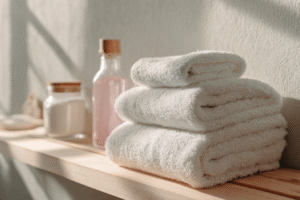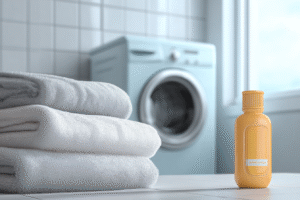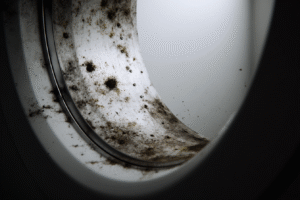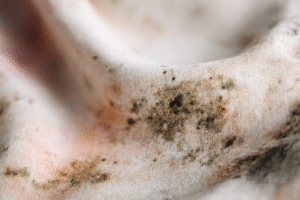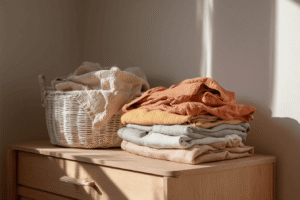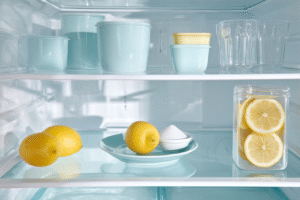Summarise this article with:
Spotted some uninvited guests on your curtains? We’re talking about mould – not your mother-in-law! Mould on curtains is surprisingly common, especially in UK homes where condensation and damp can be an everyday nuisance. It’s unsightly, can smell musty, and even trigger health issues. But don’t worry – mould on curtains isn’t a life sentence. With the right steps, you can get your curtains looking fresh again.
In this guide, we’ll walk you through exactly why mould appears, how to remove it (whether you prefer the hand washing method or whether you prefer to use a washing machine), and how to keep it from creeping back. No need to panic – just follow our easy, step-by-step methods and enjoy a cleaner, healthier home in no time.
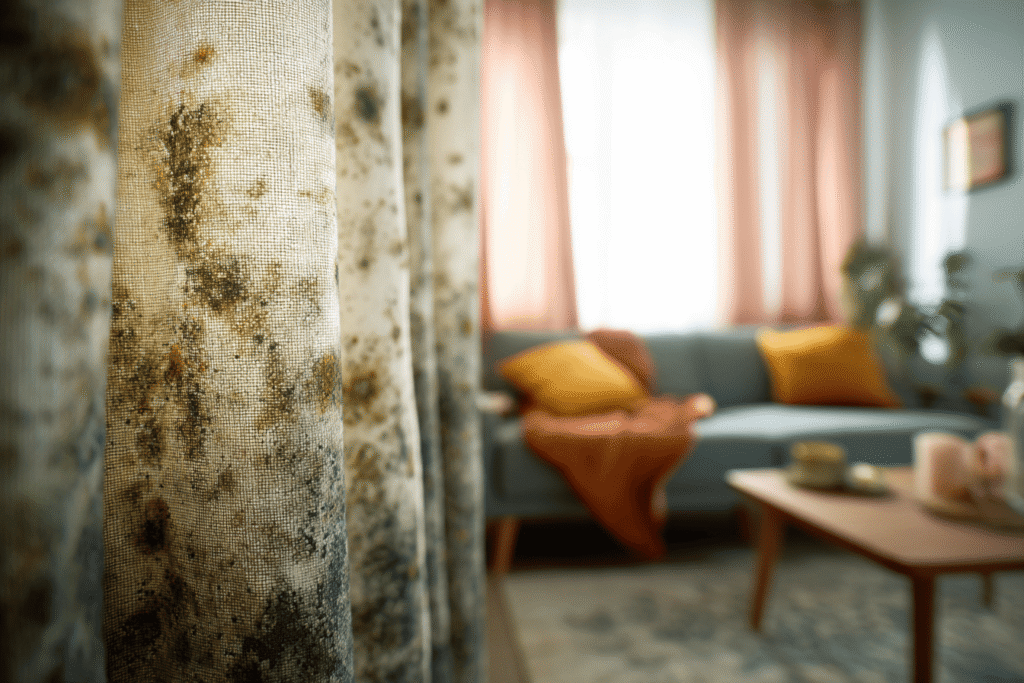
What Causes Mold on Curtains?
Mould growth on curtains typically happens when excess moisture meets poor ventilation – it’s like a perfect storm for these unwelcome fungi.
Windows are the main culprit here. When warm air hits cold glass, condensation forms, creating a breeding ground for mould spores. Those droplets of moisture get absorbed by your curtains, and before you know it, you’ve got a mould issue on your hands.
UK homes, particularly in autumn and winter, tend to have higher humidity levels. Pair that with central heating and limited ventilation, and it’s a mould magnet!
Certain curtain materials are also more vulnerable. Net curtains and delicate fabrics absorb moisture more easily, while curtains with thermal backing can trap damp against the wall. Knowing what you’re dealing with is key to treating it properly.
Is Mould on Curtains Dangerous?
Yes – mould on curtains can be more than just a cosmetic issue. Mould spores can trigger allergies, breathing problems, and even worsen asthma symptoms. If left untreated, they can spread to nearby walls, skirting boards, and ceilings.
The good news? Acting fast prevents further damage. A quick, targeted response can stop the mould in its tracks and restore a healthier home environment.
How to Remove Mould from Curtains: Step-by-Step Methods
Right then, let’s roll up our sleeves and get stuck in! Here are three tried-and-tested methods for different situations.
Method 1: Machine Washable Curtains
- Check the label first. Not all curtains can go in the washing machine, so make sure they’re machine-safe.
- Pre-treat the mould. Mix equal parts white vinegar and water in a spray bottle. Spray the affected areas and leave for 30 minutes.
- Wash on a gentle cycle. Add baking soda or hydrogen peroxide to your laundry detergent for extra mould-fighting power. Avoid bleach, as it can damage fabric.
- Dry thoroughly. If the weather allows, hang your curtains outside in direct sunlight. UV rays naturally kill mould spores and help air out lingering smells. You can see our article on how to properly clean your curtains.
Method 2: How to Remove Mould from Curtains Without Washing
Not all curtains can handle a spin in the washing machine, but that doesn’t mean you’re stuck with mouldy curtains forever!
Take your curtains outside first – we can’t stress this enough. Use the upholstery attachment on your vacuum cleaner to gently remove loose mould spores. Dispose of the vacuum bag immediately afterwards to prevent spreading spores around your home.
Create a cleaning solution using one part white vinegar to four parts water in a spray bottle. Spray the affected areas liberally and let the solution work its magic for about 20 minutes. Use a clean cloth to gently dab (don’t rub!) the treated areas.
For stubborn mould stains, try a paste made from baking soda and water. Apply it to the mouldy areas, leave for 30 minutes, then gently scrub with a soft brush before wiping clean.
Method 3: Dry Cleaning Mold for Delicate Fabrics
Some curtains are just too precious for DIY treatment. If your curtains are marked “dry clean only” or you’re dealing with expensive delicate fabric, it’s best to leave it to the professionals.
Take your curtains to a reputable dry cleaner and explain the mould issue. Professional cleaners have specialised equipment and cleaning agents that can tackle mould without damaging your curtains. The removal process might cost a bit more, but it’s worth it to save your investment.
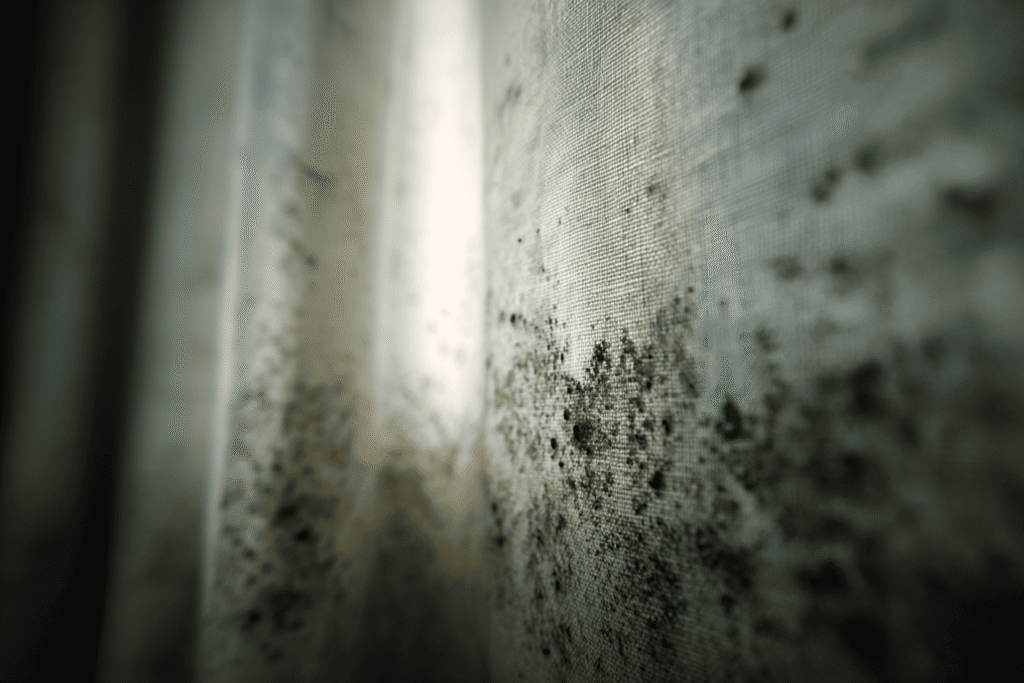
Special Cases: Different Curtain Types
Removing Mold Stains Out of Net Curtain Fabrics
Net curtains need extra TLC. These lightweight beauties are particularly susceptible to mould because they don’t always get proper air circulation. The best way to clean them is with a gentle hand wash using mild detergent and white vinegar.
Soak them in cool water with a cup of white vinegar for about an hour, then rinse thoroughly. Always air dry net curtains – the heat from tumble dryers can damage the delicate fibres.
How to Remove Black Mould from Fabric Curtains
Black mould is the villain of the mould world, but don’t let it intimidate you. The above methods work brilliantly in removing black mould, but you might need to repeat the process for particularly stubborn mould stains.
Hydrogen peroxide is another powerful ally against black mould. Mix one part hydrogen peroxide with two parts water and apply to affected areas. Always test on an inconspicuous area first to check for colour fastness.
Curtains with Thermal Backing Treatment
These clever curtains help keep your energy bills down, but that thermal backing can trap moisture and create perfect conditions for mould growth. The good news is that the above methods work well, just be extra gentle with the backing material.
Avoid high temperatures when washing, and never wring or twist the curtains as this can damage the thermal backing. Instead, gently squeeze out excess water and hang them properly to maintain their shape.
Prevention: Stop Mould Coming Back
Prevention is key. Open your windows regularly to let moisture escape and allow fresh air to circulate. Keep furniture away from walls to avoid damp build-up, and consider using a dehumidifier in trouble spots.
Wash or vacuum curtains every few months and inspect for early signs of mould. In damp-prone areas, consider moisture-resistant curtain fabrics or linings designed to breathe.
When to Call the Professionals
If the mould keeps returning or has spread to the walls and ceilings, it’s time to call in the experts. Persistent mould may indicate underlying damp or ventilation issues that need professional assessment. Look out for musty smells, black spots on paintwork, or mould patches that keep coming back no matter how often you clean. Don’t ignore the signs – early action can save you bigger repairs later.
Mould on curtains isn’t the end of the world – and it’s definitely fixable. Whether you’re machine washing, spot cleaning, or calling in pros, there’s a solution for every curtain type. Stay on top of moisture and keep the fresh air flowing, and your curtains can stay mould-free for good. Here’s to fresher, cleaner windows and a happier, healthier home!



